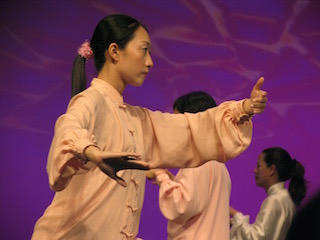Taijiquan Training part 3
See also our other tips for beginners for Taijiquan Training on our Basics of Tai Chi site!
Goal: Eliminate chronical or posture-related health problems

Some illnesses or diseases may not respond to the more superficial exercises of a wellness-style Qigong or Taijiquan. Examples are old injuries which developed into a body changing posture due to the patient’s try to avoid pain or shortened sinews after surgery or immobilisation of parts of the body after a bone fracture. But also sitting occupations in the workplace or computer work can evoke back pain, neck pain, let alone the so-called “mouse hand” or “tennis elbow”. – You “train” to assume these kinds of wrong seated “work postures” five days a week, eight to nine hours a day, if you are working full time. To change these habits, you will have to retrain your musculoskeletal system by lengthening the shortened sinews and building up underused muscles.
This requires regular and concentrated training, meaning daily training for a long period of time. – As a rule, activating the muscles will take 4-6 weeks, strengthening of the tendons and ligaments will take at least 6 months and the joints and bones are a permanent task.
Tip: You should train persistently and with concentration, but not always. After 6 days of practising, you should rest one day.
Serious health qigong exercises require dedication to your goal. Just because the movements seem effortless when you are watching a Qigong video, it does not mean that doing the exercises without effort is the same thing. It is a common misconception in Qigong and Taijiquan that effortlessness can be reached without bodily effort just by “freeing the mind” and “letting go” of tensions. This kind of practising is not necessarily harmful, but it will not help either as it is in your mind only. It is wasted lifetime.
Tip: Move out of your comfort zone! Even if it sounds harsh, to some conditions the rule “no pain, no gain” applies with all its consequences.
After some time of serious exercising of your muscles and some more intensive stretching during your practice, you will experience a strengthening of your base, i.e. the legs and the feet. Working on the base is a corner stone of Qigong and Taijiquan systems. It means that now, you begin to stand with both feet firmly on the ground. That will ultimately allow you to release the tension in the upper body. You will be able to experience relaxation not as being simply being tensionless, as e.g. lying on the couch to relax, but as a fascinating interaction of tension and guided tension release: relaxation in movement, the harmonic alternation of Yin and Yang! This is what is necessary to increase your movement range and to correct your posture in a natural way, following the skeletal and muscular structures of the human body.
Author: Taiji Forum
Images: Taiji Forum

